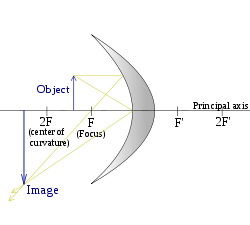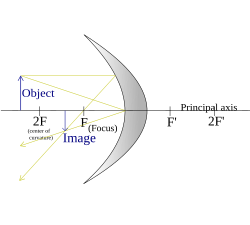Curved mirror
A curved mirror is a mirror with a curved reflective surface, which may be either convex (bulging outward) or concave (bulging inward). Most curved mirrors have surfaces that are
Convex mirror
A convex mirror, fish eye mirror or diverging mirror, is a curved mirror in which the reflective surface bulges toward the light source. Convex mirrors reflect light outwards, therefore they are not used to focus light. Such mirrors always form a virtual image, since the focus (F) and the centre of curvature (2F) are both imaginary points "inside" the mirror, which cannot be reached. Therefore images formed by these mirrors cannot be taken on screen. (As they are inside the mirror)
A collimated (parallel) beam of light diverges (spreads out) after reflection from a convex mirror, since the normal to the surface differs with each spot on the mirror.
Image

The image is always virtual (rays haven't actually passed through the image,their extensions do), diminished (smaller), and upright . These features make convex mirrors very useful: everything appears smaller in the mirror, so they cover a wider field of view than a normal plane mirror does as the image is "compressed".
Uses

The passenger-side mirror on a car is typically a convex mirror. In some countries, these are labelled with the safety warning "Objects in mirror are closer than they appear", to warn the driver of the convex mirror's distorting effects on distance perception.
Convex mirrors are used in some automated teller machines as a simple and handy security feature, allowing the users to see what is happening behind them. Similar devices are sold to be attached to ordinary computer monitors.
Some camera phones use convex mirrors to allow the user correctly aim the camera while taking a self-portrait.
Concave mirrors

A concave mirror, or converging mirror, has a reflecting surface that bulges inward (away from the incident light). Concave mirrors reflect light inward to one focal point, therefore they are used to focus light. Unlike convex mirrors, concave mirrors show different image types depending on the distance between the object and the mirror.
These mirrors are called "converging" because they tend to collect light that falls on them, refocusing parallel incoming rays toward a focus. This is because the light is reflected at different angles, since the normal to the surface differs with each spot on the mirror.
Image
| Object's position (S), focal point (F) | Image | Diagram |
|---|---|---|
| S < F (Object between focal point and mirror) |
|  |
| S = F (Object at focal point) |
|  |
| F < S <>F |
|  |
| S = 2F (Object at centre of curvature) |
|
|
| S > 2F |
|  |
Uses
Mirror shape
Most curved mirrors have a spherical profile. These are the simplest to make, and it is the best shape for general-purpose use. Spherical mirrors, however, suffer from spherical aberration. Parallel rays reflected from such mirrors do not focus to a single point. For parallel rays, such as those coming from a very distant object, a parabolic reflector can do a better job. Such a mirror can focus incoming parallel rays to a much smaller spot than a spherical mirror can.
Mirror equation and magnification
The Gaussian mirror equation relates the object distance (do) and image distances (di) to the focal length (f):
 .
.
The magnification of a mirror is defined as the height of the image divided by the height of the object:
 .
.
The negative sign in this equation is used as a convention. By convention, if the magnification is positive, the image is upright. If the magnification is negative, the image is inverted (upside down).
Ray tracing
The image location and size can also be found by graphical ray tracing, as illustrated in the figures above. A ray drawn from the top of the object to the surface vertex (where the optical axis meets the mirror) will form an angle with that axis. The reflected ray has the same angle to the axis, but is below it (See Specular reflection).
A second ray can be drawn from the top of the object passing through the focal point and reflecting off the mirror at a point somewhere below the optical axis. Such a ray will be reflected from the mirror as a ray parallel to the optical axis. The point at which the two rays described above meet is the image point corresponding to the top of the object. Its distance from the axis defines the height of the image, and its location along the axis is the image location. The mirror equation and magnification equation can be derived geometrically by considering these two rays.
Ray transfer matrix of spherical mirrors
The mathematical treatment is done under the paraxial approximation, meaning that under the first approximation a spherical mirror is a parabolic reflector. The ray matrix of a spherical mirror is shown here for the concave reflecting surface of a spherical mirror. The C element of the matrix is  , where f is the focal point of the optical device.
, where f is the focal point of the optical device.

Boxes 1 and 3 feature summing the angles of a triangle and comparing to π radians (or 180°). Box 2 shows the Maclaurin series of  up to order 1. The derivations of the ray matrices of a convex spherical mirror and a thin lens are very similar.
up to order 1. The derivations of the ray matrices of a convex spherical mirror and a thin lens are very similar.




1 comments:
Nice Blog, Thanks for sharing such a useful information. Contact Trafficrus.co.nz for buying Indoor Convex safety mirrors. Convex Mirrors for Sale at an affordable price.
Post a Comment